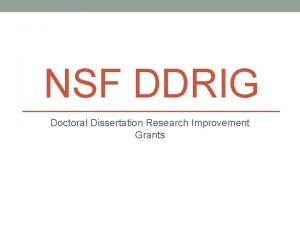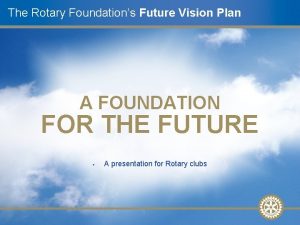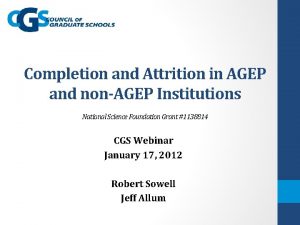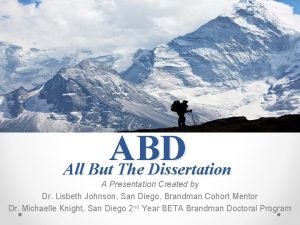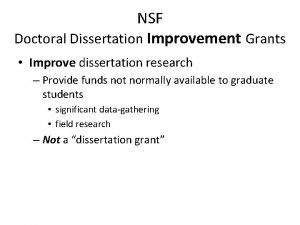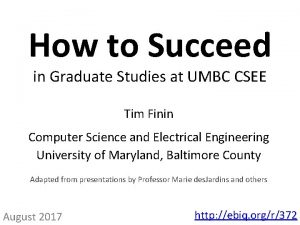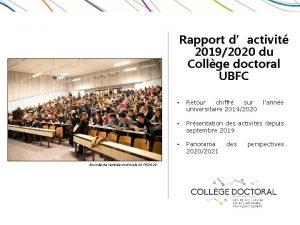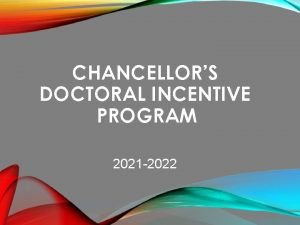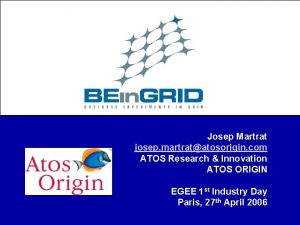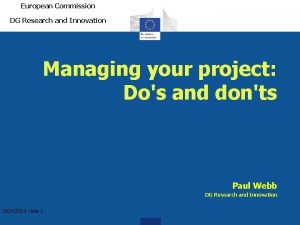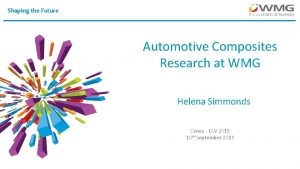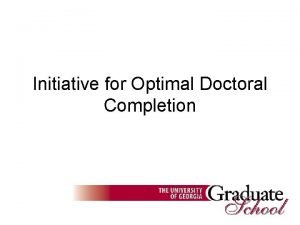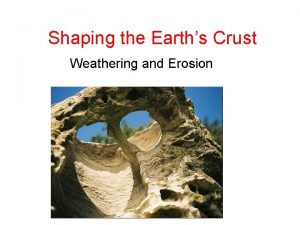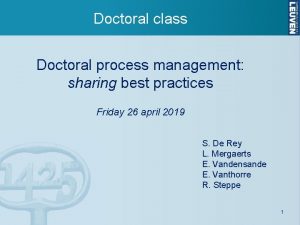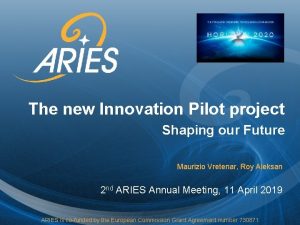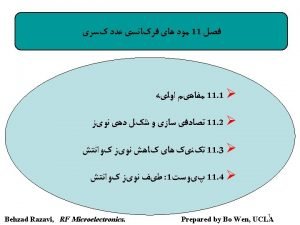Shaping the Future WMG Doctoral Research and Innovation










![The Proposed Solution Formally describe a ‘domain’ [5] “an explicit specification of a conceptualization” The Proposed Solution Formally describe a ‘domain’ [5] “an explicit specification of a conceptualization”](https://slidetodoc.com/presentation_image_h/a2c9aeb231dc5fbec10eb73928ff19fd/image-11.jpg)















- Slides: 26

Shaping the Future WMG Doctoral Research and Innovation Conference 30 th June - 1 st July A PEM fuel cell ontology to facilitate assembly line generation using a semantic approach: A proof of concept Mussawar Ahmad mussawar. ahmad@warwick. ac. uk Supervisors Prof. Robert Harrison Dr. James Meredith Dr. Axel Bindel

Outline § Fuel cell background § Problem identification – manufacturing know-how § A proposed solution using knowledge representation § Model description § Test and results § Conclusion § Further work

Background § Automation Systems Group – WMG – Automation in manufacturing – Process control – Virtual engineering – Tools developed for virtual commissioning § Partnered with Arcola Energy on Innovate UK – Fuel Cell Manufacturing Project § Collaboration with Tampere University of Technology (TUT) § Ph. D sponsored by EPSRC and High Speed Sustainable Manufacturing Institute (HSSMI)

Fuel Cells – General Types Proton Exchange Membrane

PEM - Operation

PEM Applications and Types Power (W) 10 100 500 1000 2000 5000 10000 50000 100000 Horizon Educational The H-Series stacks are not designed with a specific application in mind Air cooled Horizon H-series Horizon XP-series Horizon AEROSTACKS Horizon MFCs Ballard FCgen 1020 ACS Liquid cooled Ballard FCgen 1300 Nuvera Orion Ballard FCvelocity 9 SSL

PEM - Power Single Cell Fuel cell stack More cells = More voltage = Taller stack Larger surface area = More current = “Fatter” stack Find the right balance to meet POWER needs

PEM Assembly Diffusion layers Gaskets Membrane “Sub”-cell Also referred to as an MEA (membrane electrode assembly)

PEM Assembly Open cathode Stack Closed cathode stack More power More complexity But…there is an underlying commonality! If you can make one, can you make them all? Liquid cooled stack

The Problem Fuel cells are great, but… Lack of hydrogen infrastructure Costly compared to incumbent technologies Material costs Assembly costs: • 10 -30% [1] of labour • Up to 50% of total manufacturing [2, 3] Assembly Know-how Manufacturing costs Component manufacture Equipment Criticality Processes Tolerances Methods Sequence Control [1] J. L. Nevins and D. E. Whitney, “Concurrent design of product and processes, ” Mc. Graw-Hill, New York, 1989 [2] U. Rembold, C. Blume, and R. Dillmann, “Computer- integrated manufacturing technology and systems, ” Mar-cel Dekker, New York, 1985 [3] S. S. F. Smith, “Using multiple genetic operators to re-duce premature convergence in genetic assembly plan-ning, ” Computers in Industry, Vol. 54, Iss. 1, pp. 35– 49, May 2004.
![The Proposed Solution Formally describe a domain 5 an explicit specification of a conceptualization The Proposed Solution Formally describe a ‘domain’ [5] “an explicit specification of a conceptualization”](https://slidetodoc.com/presentation_image_h/a2c9aeb231dc5fbec10eb73928ff19fd/image-11.jpg)
The Proposed Solution Formally describe a ‘domain’ [5] “an explicit specification of a conceptualization” [4] Knowledge-base Ontology Capture Store Extensible Scalable Flexible Reuse Knowledge Know-how [4] T. R. Gruber, A translation approach to portable ontology specifications. Knowledge Acquisition, 5(2): 199 -200, 1993 [5] Jose L. Martinez Lastra, Ivan M. Delamer, Fernando Ubis; Domain Ontologies for Reasoning Machines in Factory Automation; ISBN: 978 -1 -936007 -01 -1, 2010; 138 pages

Ontological model - PPR Ontology Product Domain How to put it together? Process Domain Resource Domain Enterprise Domain Volumes Requirements Cost Use parametric product CAD to quickly assess what changes may be required on the manufacturing system. What is needed? Factory commissioning Product Characteristics What is being made? Customer/ Competition Semantic rules Mapping Axioms Virtual engineering and commissioning too

Ontological Model § § § § § Used Protégé - an ontology editor Uses a semantic language – Web Ontology Language (OWL) Extension of Resource Description Framework (RDF) Queried using SPARQL Protocol and RDF Query Language (SPARQL) Rules can be written in Semantic Web Rule Language (SWRL) RDF-based models are RDF triples which semantically describe concepts Mimics and formalises natural language Model has classes, hierarchies and relationships These are used to describe real world concepts Subject Predicate Object Fuel. Cell has. Type PEMFuel. Cell has. Variant Open. Cathode. Stack has. Component Anode. Flow. Field. Plate has. Liaison. With Anode. GDL

What do the domains look like? Product Domain

What do the domains look like? Process Domain

What do the domains look like? Resource Domain

The bigger picture

The even bigger picture Ontology Product Domain How to put it together? Process Domain What is needed? Resource Domain Enterprise Domain Volumes Requirements Cost Factory commissioning Product Characteristics What is being made? Customer/ Competition Semantic rules Mapping Axioms Virtual engineering and commissioning too

Liaisons and Precedence This method allows the modelling of the PROCESS SEQUENCE and thus the ASSEMBLY EQUIPMENT CONFIGURATION

Model Only modelled the relationship between the GDLs and the CCM to test…

Testing and Results § Queries are written using SPARQL to test the model § Two tests were carried out 1. Check that the mappings results in the selection of appropriate equipment Product Domain Process Domain Resource Domain 2. Check the model technique for precedence works

Query 1 Correctly selected appropriate assembly equipment i. e. Robot + gripper

Query 2 Correctly ordered and labelled the liaisons between components

Conclusion § The concept has been proved – Equipment can be generated – Sequence model works § Designed to allow the addition of more information in the future § Some progress on building a fuel cell assembly KB § BUT – It’s a time consuming process – Concepts being modelled are simple - unforeseen complexity may need a model redesign

Further Work Use parametric product CAD to quickly assess what changes may be required on the manufacturing system. XML File Ontology What is being made? How to put it together? Product Domain Process Domain What is needed? Resource Domain XML File Enterprise Domain Customer/ Competition Volumes Requirements Cost Virtual engineering and commissioning tool

Acknowledgement Questions Contact Details: Mussawar Ahmad mussawar. ahmad@warwick. ac. uk
 Nsf ddrig sociology
Nsf ddrig sociology Future perfect vs future continuous exercises
Future perfect vs future continuous exercises Esercizi future continuous e future perfect
Esercizi future continuous e future perfect Innovation for the sake of innovation
Innovation for the sake of innovation Incremental innovation vs disruptive innovation
Incremental innovation vs disruptive innovation মাইক্রোক্রেডিট
মাইক্রোক্রেডিট Doctoral initiative on minority attrition and completion
Doctoral initiative on minority attrition and completion South west doctoral training partnership
South west doctoral training partnership Eui doctoral programme
Eui doctoral programme All but dissertation (abd) status
All but dissertation (abd) status Nsf doctoral dissertation improvement grant
Nsf doctoral dissertation improvement grant Umbc doctoral programs
Umbc doctoral programs College doctoral ubfc
College doctoral ubfc Power point tesis doctoral medicina
Power point tesis doctoral medicina Csu doctoral incentive program
Csu doctoral incentive program Business innovation
Business innovation Martrat
Martrat Dg research and innovation
Dg research and innovation Future perfect and future continuous examples
Future perfect and future continuous examples Tenses
Tenses Future plans and finished future actions
Future plans and finished future actions Future continuous and future perfect
Future continuous and future perfect Kondicional 1 engleski
Kondicional 1 engleski Rdi research development innovation
Rdi research development innovation Future vs future perfect
Future vs future perfect Tense chart class 9
Tense chart class 9 Future nurse future midwife e learning
Future nurse future midwife e learning
